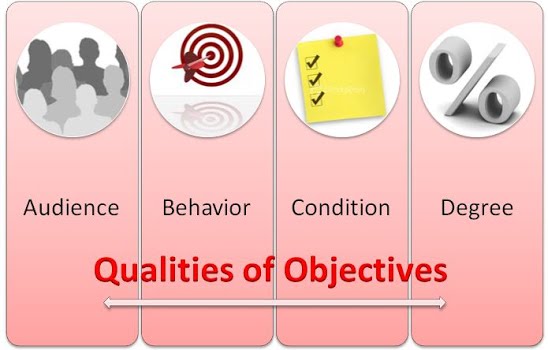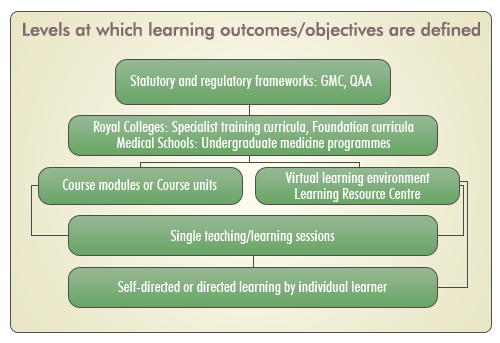Defining learning objectives and outcomes is one of the most important steps in developing corporate training. Well defined learning objectives and outcomes enable both the trainers and the learners to know what to be taught and how to participate in the learning process, while the supporting organization knows what to expect from the process. These expectations, concretely, will be in the form of what the learner will know (cognitive outcomes), how they will be able to think (affective outcomes), and/or what they will be able to do (behavioral outcomes). Learning objectives and outcomes also help stakeholders to understand what will be achieved by a training program and how to support it.
The following are major reasons why you should take the time to define clear and measurable / observable learning objectives and outcomes.
1. Learning outcomes and objectives offer a framework for trainers to organize the training by focusing on the key content and eliminating unnecessary content.
Well defined learning objectives and outcomes help ensure that a given training program is balanced in terms of content choice and presentation methods. Studies shows that adult learners prefer to be independent and self-directed (Lajoie, 2003). This means that programs for corporate training should allow for such independence and self-directing. But this is not a vote for improvisation so much as planning for open-ended objectives. Well defined objectives offer an avenue for instructors and course coordinators to design and organize learning in such a way that it allows learners greater autonomy and room for creativity. In fact, a meta-analysis study of 70 smaller studies revealed that novice learners given insufficient guidelines during a training program experienced greater learning losses with no apparent learning gains (Clark, 1989). Different studies, on the other hand, suggest that too many direct instructions to advanced learners interferes with the learning process (Kalyuga, Ayres, Chandler,& Sweller, 2003). For these reasons, it’s important to consider the learner’s knowledge level when developing learning objectives and outcomes and when designing the training program, and ensure that the appropriate balance of guidance and freedom is in place.
2. Well defined learning objectives ensure that the desired training goals are met by offering a framework to review / assess the program.
Learning objectives and outcomes are put in place to ensure that learners learn and practice the right set of skills, knowledge and attitudes so as to meet the aims of the training program. Clear objectives and outcomes help in the continuous review of a training program to ensure that learners are focused on practices that are geared towards meeting established goals.
3. Learning objectives and outcomes guide in the choice of the appropriate learning materials and methods for the training.
Well defined learning objectives and outcomes play a crucial role in helping offer guidance on the choice of learning materials and teaching methods. These are key elements of any training program. So it is important for instructors and learners to carefully pick learning materials so as to maximize the benefits of a given training program.
4. Learning objectives and outcomes help inform both instructors and learners about different sets of skills to be learned.
Well defined learning objectives help learners know the different sets of skills and attitudes to be developed during the training program. Research shows that students who know the set of skills a given learning program will be imparting are more focused on mastering these skills than when they do not. Research has also revealed that learners at any given level perform better when their training program is focused on a specific set of skills and attitudes. In fact, according to a study by Rothkopf and Billington (1979), learners who had specific objectives paid more attention to relevant content for meeting those objectives than those who did not!
Levels at which Learning Objectives and Outcomes are defined
Source: London Deanery (2012)
There are numerous other benefits that come from well formulated learning objectives and outcomes in a corporate training program. Here are some of these other benefits:
- Instructors and learners have a clear picture of the expected behavior at the end of the training program.
- Instructors can more readily and more intelligently adjust the teaching methods employed to meet the desired goals.
- Instructors and the organization can will have a framework for evaluating the learning process.
- Instructors and the organization gain a systematic approach to designing a training program.
Despite the numerous benefits of defining training objectives and outcomes, quite a number of organizations still fail to do so. Here are a number of problems you might experience if you fail to develop clear objectives and outcomes for your training programs.
- Difficulty in assessing the success of your program.
- Mismatch between the training content and the skills gap in your organization.
- Lack of proper organization during training.
- Poorly selected or inappropriate instructional methods and content.
- Poorly designed training program.
Defining clear and measurable objectives and outcomes for training can be challenging for L&D organizations. Luckily, Reva Digital provides L&D solutions including curriculum development and instructional design to help you along the way. Are you ready to design learning for impact? Leave your comments below.


